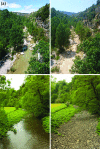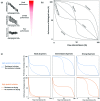A Metacommunity Approach to Improve Biological Assessments in Highly Dynamic Freshwater Ecosystems
- PMID: 32440024
- PMCID: PMC7231578
- DOI: 10.1093/biosci/biaa033
A Metacommunity Approach to Improve Biological Assessments in Highly Dynamic Freshwater Ecosystems
Abstract
Rapid shifts in biotic communities due to environmental variability challenge the detection of anthropogenic impacts by current biomonitoring programs. Metacommunity ecology has the potential to inform such programs, because it combines dispersal processes with niche-based approaches and recognizes variability in community composition. Using intermittent rivers-prevalent and highly dynamic ecosystems that sometimes dry-we develop a conceptual model to illustrate how dispersal limitation and flow intermittence influence the performance of biological indices. We produce a methodological framework integrating physical- and organismal-based dispersal measurements into predictive modeling, to inform development of dynamic ecological quality assessments. Such metacommunity-based approaches could be extended to other ecosystems and are required to underpin our capacity to monitor and protect ecosystems threatened under future environmental changes.
Keywords: bioassessment; climate change; connectivity; dispersal; intermittent rivers and streams.
© The Author(s) 2020. Published by Oxford University Press on behalf of the American Institute of Biological Sciences.
Figures




References
-
- Alba-Tercedor J et al. .. 2002. Caracterización del estado ecológico de ríos mediterráneos ibéricos mediante el índice IBMWP (antes BMWP’). Limnética 21: 175–185.
-
- Allen DC, Kopp DA, Costigan KH, Datry T, Hugueny B, Turner DS, Bodner GS, Flood TJ. 2019. Citizen scientists document long-term streamflow declines in intermittent rivers of the desert southwest, USA. Freshwater Science 38: 244–256.
-
- Aroviita J, Mykrä H, Muotka T, Hämäläinen HE. 2009. Influence of geographical extent on typology- and model-based assessments of taxonomic completeness of river macroinvertebrates. Freshwater Biology 54: 1774–1787.
-
- Beirinckx K, Van Gossum HJ, Lajeunesse M R, Forbes M. 2006. Sex biases in dispersal and philopatry: Insights from a meta-analysis based on capture–mark–recapture studies of damselflies. Oikos 113: 539–547.
-
- Birk S, Bonne W, Borja A, Brucet S, Courrat A, Poikane S, Solimini A, van de Bund W, Zampoukas N, Hering D. 2012. Three hundred ways to assess Europe's surface waters: An almost complete overview of biological methods to implement the Water Framework Directive. Ecological Indicators 18: 31–41.

